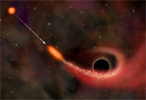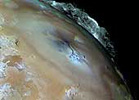An overview of the Chandra mission and goals, Chandra's namesake, top 10 facts.
Classroom activities, printable materials, interactive games & more.
Overview of X-ray Astronomy and X-ray sources: black holes to galaxy clusters.
All Chandra images released to the public listed by date & by category
Current Chandra press releases, status reports, interviews & biographies.
A collection of multimedia, illustrations & animations, a glossary, FAQ & more.
A collection of illustrations, animations and video.
Chandra discoveries in an audio/video format.
The Nature of Tidal Forces
February 18, 2004 ::
The force of gravity is usually considered a binding force in the universe
- holding the planets in orbit around the Sun, keeping galaxies and
clusters of galaxies together. However, gravity can also be a destructive
force, tearing objects to pieces, especially in the vicinity of a
supermassive black hole.
How does this happen? The force of gravity depends on distance,
strengthening when you move towards an object. For example, imagine you
are in a large spaceship, traveling towards a black hole. As you near the
black hole, the tug of gravity on the front of the ship will become much
stronger than the tug on the rear. As you might guess, your spaceship
would begin to get stretched, and the closer you got to the center of the
black hole, the stronger this stretching would be. Eventually, your
spaceship would be ripped apart. This difference in gravitational force
acting on opposite ends of an object is known as a tidal force.
 |
Illustration of RX J1242-11
Illustration: NASA/CXC/M.Weiss |
Tidal forces are thought to be responsible for the huge X-ray flare
observed in the galaxy
RX J1242-11. A doomed star traveled close to the
supermassive black hole in the center of this galaxy and was torn apart by
tidal forces. Most of the gaseous debris from the star escaped the black
hole, but a small amount of material was captured by its immense gravitational pull,
forming a rotating disk of gas. Close to the black hole the heat
intensified and the disk of gas began to glow in X-rays.
Although this is the first strong evidence for a supermassive black hole
ripping a star apart, this is by no means our first experience with tidal
forces in the universe. There are many examples of the destructive work of
tidal forces in our solar system.
 |
Illustration of Comet-Shoemaker-Levy Collision with Jupiter
Illustration: JPL/D.Seal (edited by CXC/M.Weiss) |
Recall the Shoemaker-Levy comet which was first noticed in 1993, and then
carefully observed over the next year as it drew closer and closer to
Jupiter. The tidal forces on the comet were so strong that it broke into at
least 21 pieces as it fell in towards the massive planet. The final impacts
in the summer of 1994 were huge disturbances in the gaseous surface of
Jupiter.
 |
Illustration of Saturn's Rings
Illustration: NASA/CXC/M.Weiss |
Another dramatic example of the effects of tidal forces in the solar system
are the rings around Saturn. The rings are made up of many small
particles. These particles cannot clump together into a large body via
gravitational attraction because of the strong tidal forces of Saturn.
Further away from the planet, however, the tidal
forces are not strong enough to rip large objects apart and Saturn has a
stable retinue of moons outside of the ring system.
 |
Image of Pele erupting on Io
Credit: NASA/USGS |
This doesn't mean that life is calm in the planetary suburbs. Even moons
that survive tidal forces can still be hugely affected by them. Jupiter's
moons provide the most extreme example of this, especially Io which is the
most geologically active body in the solar system today. Io is being pulled
by massive Jupiter on one side and by the outer moons (Europa, Callisto,
Ganymede) on the other. The opposing tidal forces alternately squeeze and
stretch its interior, causing the solid surface to rise and fall by about
100 meters. The enormous amount of heat and pressure generated by the
resulting friction creates colossal volcanoes and fractures on the surface
of this moon.
Jupiter's moon Europa also shows visible signs of tidal forces, with
countless cracks in its icy surface. After careful analysis, the cracks and
folds in the surface appear to be the accordion like stretching and
squeezing lines of opposing tidal forces.
Of course the most familiar example of tidal forces in the universe is
right here at home, on Earth. The tides of the oceans are the result
of the combined tidal forces of the Moon and the Sun.
While it is fortunate that we can observe tidal effects in our local
neighborhood, we certainly would not be able to see the eruption of a
moon's volcano at the distance of the galaxy RX J1242-11, or the impact of
a comet fragment on a planet or star. These events are simply not bright
enough. However, two important effects allow us to observe the central
black hole tear a star apart. Firstly, the strong gravitational field of
the supermassive black hole makes the gas very hot, so that it glows in
X-rays, and secondly the stellar material is swallowed very quickly by the
black hole. These effects combine to create a flash of X-rays that is so
bright it can easily be detected with Chandra and XMM-Newton in a galaxy
like RX J1242-11, 700 million light years away.








